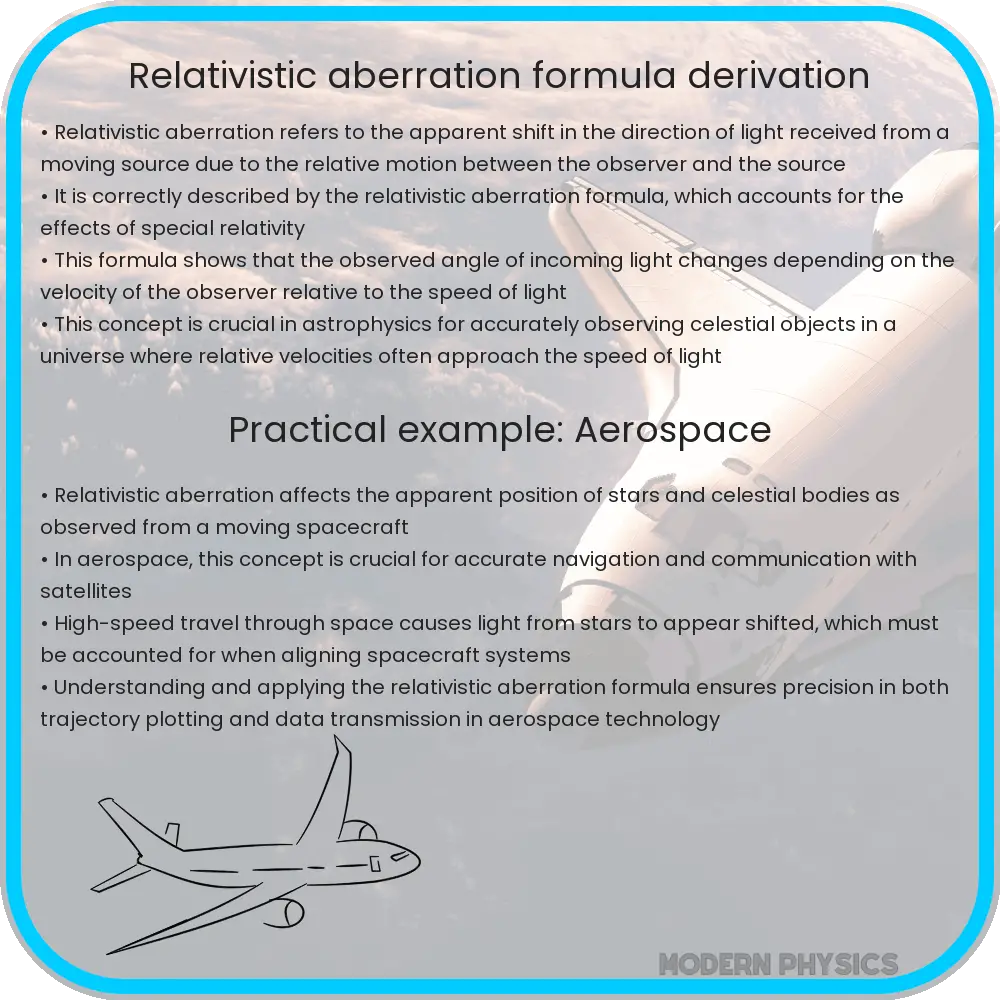Explore the fundamentals of relativistic aberration in physics, its astronomical implications, and applications in modern technology and GPS.

Understanding Relativistic Aberration: An Introduction
Relativistic aberration is a fascinating phenomenon in physics that arises due to the finite speed of light and the principles of Einstein’s theory of relativity. This concept is crucial in understanding how the apparent position of astronomical objects changes due to the motion of an observer traveling at a significant fraction of the speed of light.
Theory Behind Relativistic Aberration
The theory of relativistic aberration can be traced back to Albert Einstein’s Special Theory of Relativity, which revolutionized our understanding of space, time, and motion. According to this theory, the laws of physics are the same in all inertial frames, and the speed of light in vacuum is constant for all observers, regardless of their relative motion. This leads to various relativistic effects, including time dilation, length contraction, and the aberration of light.
Classical Aberration vs. Relativistic Aberration
Before delving into relativistic aberration, it’s essential to differentiate it from classical aberration. Classical aberration, first explained by James Bradley in the 18th century, refers to the apparent shift in the position of stars due to Earth’s motion around the Sun. However, this explanation assumes a Newtonian framework and does not account for the relativistic speeds and the constancy of light’s speed. Relativistic aberration extends this concept to include the effects predicted by Einstein’s theory.
Derivation of the Relativistic Aberration Formula
The derivation of the relativistic aberration formula begins with the Lorentz transformation, which relates the coordinates of events as measured in different inertial frames moving relative to each other. Considering a light source and an observer in relative motion, the apparent angle (θ) of the light’s arrival at the observer is different from the angle in the source’s frame of reference (θ0). The formula for relativistic aberration is given by:
\[\cos(\theta) = \frac{\cos(\theta_{0}) – \frac{v}{c}}{1 – \frac{v}{c}\cos(\theta_{0})}\]
where:
- v is the relative velocity between the observer and the source,
- c is the speed of light,
- θ0 is the angle of the light in the source’s frame, and
- θ is the observed angle in the observer’s frame.
Implications of Relativistic Aberration in Astronomy
Relativistic aberration has profound implications in the field of astronomy. It affects the observed positions of celestial bodies, especially those observed from high-speed spacecraft or astronomical objects moving at relativistic speeds. This phenomenon is critical in accurately determining the position and movement of distant stars and galaxies. It also plays a significant role in the study of binary star systems and pulsars, where relativistic effects are more pronounced.
Applications in Modern Physics and Technology
Beyond astronomy, relativistic aberration finds applications in modern physics and various technological fields. For instance, it is a crucial consideration in the design of high-speed communication systems and in the Global Positioning System (GPS), where the accuracy of signal transmission can be affected by the relative motion of satellites and receivers. Understanding and accounting for relativistic aberration ensures the precision and reliability of these systems.
Challenges and Future Research
Despite its established theoretical foundations, relativistic aberration continues to pose challenges, particularly in its experimental verification and application in rapidly advancing fields. Future research may focus on exploring its effects in extreme conditions, such as near black holes or in high-energy particle accelerators, and in the emerging field of relativistic engineering.
Conclusion
Relativistic aberration is a cornerstone concept in modern physics, offering deep insights into the nature of light, motion, and the structure of the universe. It demonstrates the profound implications of Einstein’s theory of relativity in understanding the universe. As technology advances, its relevance extends beyond theoretical physics, impacting practical applications in astronomy, communication, and navigation. Continued exploration and understanding of relativistic aberration will undoubtedly contribute to further advancements in science and technology, highlighting the ever-evolving nature of our understanding of the cosmos.
